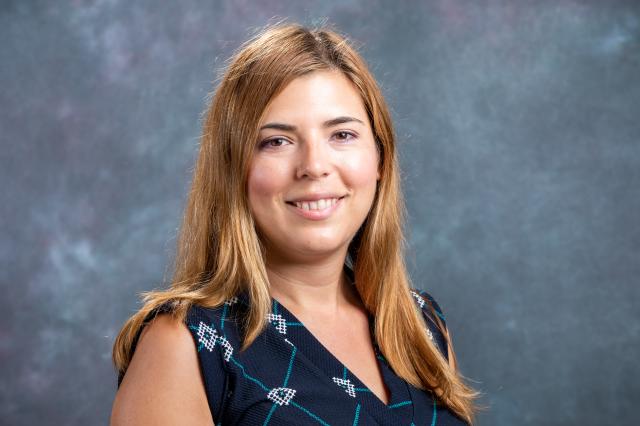Active Research Projects - Apply Today!
Iyad Ghanim, Ph.D.

Assistant Professor
The College of Health Professions and Human Services
Directory
Hemispheric processing of semantic information in words and sentences
To comprehend language, individuals combine the totality of the utterance they hear with
information from the individual words. This process may be more complicated for bilinguals,
who may have a lesser ability to use context to facilitate comprehension. In his research, Dr.
Ghanim explores how people, especially bilinguals, extract meaning from the language that they
hear and negotiate between sources of information when processing language. One such project
entails comparing the differences in the two cerebral hemispheres with regards to how that
information is extracted, processed, and used to facilitate comprehension. In another related
project, differences between bilingual subgroups are examined and compared. Currently, Dr.
Ghanim is validating existing measures of reading assessments in bilinguals.
Students researchers will work on human subjects recruitment, data collection and experimental
administration in our lab space, and preparation of data files. Students will be mentored by Dr.
Ghanim and graduate assistants.
Irina Gioaba, Ph.D.

Equity In Action Postdoctoral Fellow
Department of Marketing, Global Business and Economics
Directory
Ageist language in job ads and its impact on applicant behavior
The past few decades have witnessed a tremendous increase in workforce participation among the older segment of the population. Nevertheless bias and discrimination against older workers remains a pervasive phenomenon. Although the nature of discrimination has changed, with fewer instances of blatant overt discrimination, subtle forms continue to pose challenges for individuals over 50 looking for employment. Recent research has suggested that certain organizational practices may contribute to perpetuate age inequality in the workplace. One such example refers to the wording of job advertisements. Although, employers are no longer allowed to overtly advertise preference for certain groups, however they can nevertheless shape the applicant pool through subtle cues connoting certain group-associated traits and stereotypes ("technologically savvy", "flexibility", etc.). The goal is research is to investigate how applicants respond to such practices by measuring their perceptions of these job ads, the impact of their job seeking behaviors, and intentions to pursue employment.
Keri Giordano, Ph.D.

Assistant Professor
Department of Advanced Studies in Psychology
Directory
Early Childhood Suspension & Expulsion
Dr. Keri Giordano (School/Clinical Psychology) is seeking two undergraduate students to join her lab, which focuses on the mental health needs of the birth to five population. Research for the upcoming academic year will focus on issues regarding suspension and expulsion from early learning settings. Prior research has shown high rates of early childhood expulsion and factors that have influenced expulsion included race, program quality, and the COVID-19 pandemic (Giordano, 2019; Giordano et al., 2020, Giordano et al., 2021, Giordano et al., 2022). We will continue to examine factors that impact expulsion as well as perceptions regarding this practice. Student researchers will work alongside doctoral candidates in the development of studies, submission of forms, recruitment, data collection/analysis, and dissemination of results. Note- students need to be available to attend weekly team meetings on Tuesdays 11:40-12:50.
Min Chung Han, Ph.D.

Associate Professor
College of Business and Public Management
Buy Now Pay Later: Smart consumption or simple avoidance of the pain of paying
Dr. Min Chung Han (Marketing) is seeking two undergraduate students to work on her marketing research project, which is supported by Released Time for Research (RTR) program. Student researchers will be mentored by Dr. Han and will participate in several parts of the project, including: research stimuli design, survey questionnaire creation using Qualtrics, data collection, data analysis using SPSS software, and result presentation. A student who contributes to the work will have opportunities to present their work at Kean Research Days and co-authorship on presentation and papers. Students will be expected to work on the research project for 5-10 hours per week and will receive a stipend.
Supratik Kar, Ph.D.

Assistant Professor
The Dorothy and George Hennings College of Science, Mathematics and Technology
Computer-aided Drug Discover for Zika Virus
The Zika virus (ZV), transmitted primarily by Aedes mosquitoes, typically causes mild
symptoms like rash, fever, and joint pain, though many infected individuals remain asymptomatic.
Despite the generally low risk of severe illness, Zika poses significant concerns for pregnant
women, as it can lead to congenital malformations such as microcephaly in infants and is
associated with neurological conditions like Guillain-Barré syndrome. The estimated risk of
congenital malformations is between 5–15% in infants born to infected mothers during pregnancy,
and although mortality rates are low, severe complications can arise.
Currently, there are no US FDA-approved treatments or vaccines for ZV, underscoring the
potential for a future pandemic due to the virus's capacity for mutation. Research has identified
five key proteins in ZV's life cycle as targets for drug discovery: NS3 Protease/Helicase, NS5
RNA-Dependent RNA Polymerase (RdRp), NS5 Methyltransferase, Capsid Protein, and Envelope
(E) Protein. The NS5 RdRp, crucial for viral replication and conserved across flaviviruses, is
considered a prime target for drug development efforts. The lack of approved treatments prompts
a focus on repurposing existing FDA-approved small molecules using computational techniques
such as docking, molecular dynamics, machine learning, and ADMET profiling. This approach
aims to streamline the drug discovery process, improving time and cost efficiency while
minimizing late-stage failures. Ultimately, this research could significantly enhance healthcare
quality by providing effective treatments for ZV.
In silico Modeling of Aquatic Toxicity of Organic Chemical to Popular and Rare Fish Species: Mechanistic Study and Ecotoxicity Gap Filling
The Toxic Substances Control Act (TSCA) requires the US Environmental Protection
Agency (EPA) to have a detailed report of any chemical that is manufactured or processed as well
as imported in the United States. The TSCA Active Inventory includes about 86,000 chemicals
with hundreds to thousands of new substances added every year. Therefore, having toxicological
data in the means of experimental toxicological study is close to impossible considering the huge
dimension of toxicity endpoints to study. Thus, in silico models like QSAR, read-across, and
machine learning can be employed strategically to support testing prioritization of the chemical
for which no ecotoxicity data are available.
My lab has already created in silico toxicity models for Tilapia, Labeo rohita (Rohu Fish),
trout and salmon. Two of the works have already been published in high-impact factor Q1 journals.
Over the next three years, my lab will develop silico toxicity models for another 10 fishes
employing cheminformatics to fill the toxicity data gaps and risk assessment of industrial
chemicals to these fishes.
Protein Binding Affinity as the Driver for Studying PFAS Mixture Toxicity
The purpose of this project is to use a combination of in silico, in vitro, and in vivo tools to test the overarching hypothesis that the binding of per- and polyfluoroalkyl substances (PFAS) to hemoglobin (Hb) is a physiological signal for predicting the toxicity of PFAS mixtures. Using PFAS concentrations and ratios of mixtures found in surface and drinking water across the USA, we will quantify the binding of single PFAS and their mixtures to hemoglobin. My lab is responsible for the computational part while Prof. Sepulveda’s lab of Purdue University is responsible for in vitro and in vivo part of the research.
Criteria:
- Students should be from Chemistry, Biology, Computer science, or environmental science major or minor.
- During the time of application, students should have 3.0 or higher GPA.
- Students from Freshman, Sophomore, or Junior years are preferred.
- Students will be expected to work on the project for 5 - 10 hours per week and will receive a stipend.
Students who contribute meaningfully to the work will have opportunities for co-authorship on presentations and papers.
Daehan Kwak, Ph.D.

Assistant Professor
The Dorothy and George Hennings College of Science, Mathematics and Technology
Collaborative Research: CISE-MSI: RCBP-RF: CPS: Socially Informed Traffic Signal Control for Improving Near Roadway Air Quality
Dr. Daehan Kwak (Computer Science) is seeking motivated undergraduate and graduate students to participate in a collaborative NSF-funded research project with Lehigh University, focused on improving air quality near roadways through advanced traffic signal control systems. As part of our team, you will engage in tasks such as developing low-cost air quality sensing systems, implementing machine learning-based traffic sensing models, and designing socially informed traffic signal control strategies. This unique opportunity offers mentorship, hands-on research experience, and the chance to contribute to a project with the potential to enhance air quality and the well-being of communities.
Students from underrepresented groups in STEM are especially encouraged to apply.
Brenna Levine, Ph.D.

Assistant Professor
The Dorothy and George Hennings College of Science, Mathematics and Technology
Directory
Effects of urbanization on the evolutionary dynamics of invasive species range expansion
Dr. Brenna Levine (Biology) is seeking two motivated undergraduate students to work on her NSF-funded spotted lanternfly evolution project. Student researchers will work on numerous aspects of the project including: DNA extraction, spotted lanternfly rearing, field data collection, analysis, and growing/maintenance of tree-of-heaven plants. Student researchers will be mentored by Dr. Levine and a graduate student and more senior undergraduate in the lab. Student who contribute meaningfully to the work will have opportunities for co-authorship on presentations and papers. Students will be expected to work on the project for 5 - 10 hours per week and will receive a stipend.
Freshmen, Sophomores, and Juniors requested.
Students from underrepresented groups in STEM are especially encouraged to apply.
Matthew G. Niepielko, Ph.D.

Assistant Professor
The Dorothy and George Hennings College of Science, Mathematics and Technology
Directory
Investigating mechanisms that regulate reproductive fitness in Drosophila
A fundamental requirement for animal reproduction is the development and maintenance of the germline, the set of highly specialized cells responsible for passing on genetic material to the following generation. Recent discoveries have revealed that germline function requires the formation of highly conserved ribonucleoprotein (RNP) granules called germ granules. Germ granules have essential roles in germline differentiation, proliferation, and post-transcriptional gene regulation. In animals such as Drosophila, germ cell specification occurs through the inheritance of germ granules that reside at a specific location within the egg. In humans, where germline fate is induced through signaling interactions, similar germ granules form de novo after germline differentiation. Regardless of their origin, germ granules contain highly conserved components such as mRNA encoding the translational repressor nanos (nos). Evidence supporting the conserved role of germ granules comes from the effect of mutations that eliminate conserved germ granule components in Drosophila, Xenopus, zebrafish, and mouse, which result in the loss of the germline. In humans, mutations in the nos ortholog, NANOS1, are associated with defects in spermatogenesis that result in a lack of germ cells in the testes, while mutations in NANOS3 are linked to premature ovarian failure. Despite the conserved function of germ granules, it is unclear how fertility may be affected by changes in germ granule composition. Elucidating how granule mRNA content affects fertility and the mechanisms that yield germ granule diversity should provide insight into defects such as infertility and sterility. In the Niepielko Lab, we take advantage of the natural variation of fertility found in Drosophila species to investigate the role germ granules have in reproductive robustness.
Capturing 3D pollen images using confocal micrscopy
Seasonal allergic rhinitis (SAR) is a common inflammatory condition caused by pollen grains released by trees, grasses, weeds, or molds. Many people are affected by the cold-like symptoms caused by these various pollen species. Therefore, streamlining the distribution of real-time pollen conditions is important because it can provide allergy sufferers with useful information to help reduce pollen exposure. AI can be used to automate the process of identifying and quantifying real time pollen conditions. It is hypothesized that confocal microscopy images can serve as sufficient training data for this AI program. Whereas other types of microscopes can only allow the external characteristics of samples to be seen, confocal microscopy allows a sample to be imaged in slices along its z-axis which are then used to create 3D and cross-sectional images. This allows the images to not only display the external morphologies and characteristics that are unique to each pollen species, but also the internal morphologies and characteristics. During this study, several 3D images of various pollen species were captured at various magnifications. The images were able to show and distinguish each pollen species by their distinctive characteristics. The study found that confocal microscopy can be used to produce detailed images of pollen grain species. The next step in this research would be to develop an AI program that can identify and quantify pollen on an unmodified slide of current pollen conditions. This information can then be made public online or added to a pollen database.
Applications are currently not being accepted
Pragya Sharma Ghimire, Ph.D.

Assistant Professor
The College of Health Professions and Human Services
Directory
Dietary Calcium Intake Analyses and its Relationship With Fitness Components Among College-Aged Young Adults
Dr. Pragya Sharma’s (Exercise Science) lab is currently seeking two motivated undergraduate students to join her lab for a project investigating the impact of dietary calcium intake on muscle performance. While the role of calcium in bone metabolism is well-documented, a significant research gap exists in understanding the relationship between calcium intake and muscle performance, particularly among young adults. Therefore, this study aims to compare Dietary Calcium Intake among young individuals and explore the relationship between cardiovascular and muscular performance. The importance of dietary calcium intake in bone metabolism has been well established; however, it is still less investigated in health-related components that could further help us to gain insight into muscle-bone crosstalk.
Further, Dr. Sharma’s broader research scope looks at the impact of exercise and nutrition on the molecular levels of bone metabolism, a complex sequence of bone turnover, and bone formation. Her research also involves exploring novel markers such as sclerostin, DKK-1, RANKL, and Irisin in response to exercise via signaling cascades, which can delve into the disease prevention aspect of osteoporosis/sarcopenia with exercise performance. A student’s meaningful contribution to the work may present the opportunity to present their work at Kean Research Days and co-authorship on presentations and publications. Students will be expected to work on the research project for 5-10 hours per week and receive a stipend.
Aaron van Klyton, Ph.D.

Assistant Professor
College of Business and Public Management
Directory
The challenges of digitalising the retail supply chain in East Africa
Dr Aaron van Klyton (Management and Global Business) is seeking one motivated senior undergraduate or graduate student (preferably from Sociology or Communications) to work on an interdisciplinary project on digital transformation and the reconfiguration of service ecosystems. This part of the project focuses on the failure of digital innovations to mitigate supplier debt in the fast-moving consumer goods sector in Kenya– a critical source of market friction. In this qualitative study, the student researcher will work on data management and coding, literature review, and collecting secondary data about market competitiveness. The student will be mentored by Dr van Klyton. The expectation is that the student will be open to exploring the human-technology frontier with particular attention given to the institutional and cultural factors in developing markets that affect technology acceptance. A student’s meaningful contribution to the work may present the opportunity to co-author a paper.
Rana Zeine, Ph.D.

Adjunct Instructor
The Dorothy and George Hennings College of Science, Mathematics and Technology
Directory
The Endocannabinoid System and Mechanisms of Medical Cannabis
Dr. Zeine has expertise in neuropsychiatric diseases, cancers, and autoimmune disorders. She is interested in analyzing the biologic mechanisms and clinical effectiveness of novel disease treatment modalities. Her recent publications include systematic review articles on Congenital Zika Syndrome and Chronic Traumatic Encephalopathy. Her current active projects include evaluating the effects of microgravity on pathophysiology in astronauts and cosmonauts and studying the impacts of transcranial magnetic stimulation on brain networks. She welcomes new ideas to explore topics of interest to you.